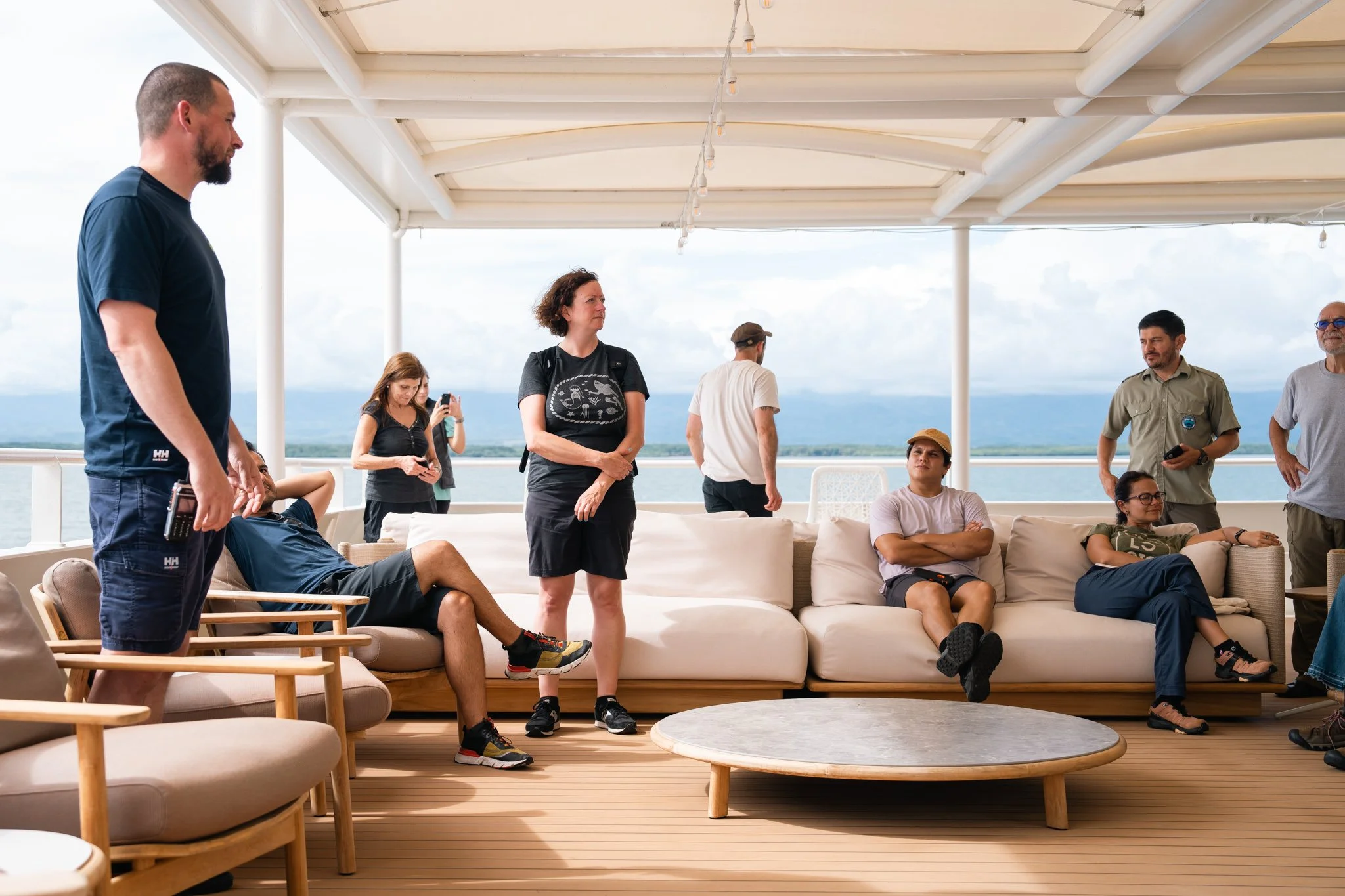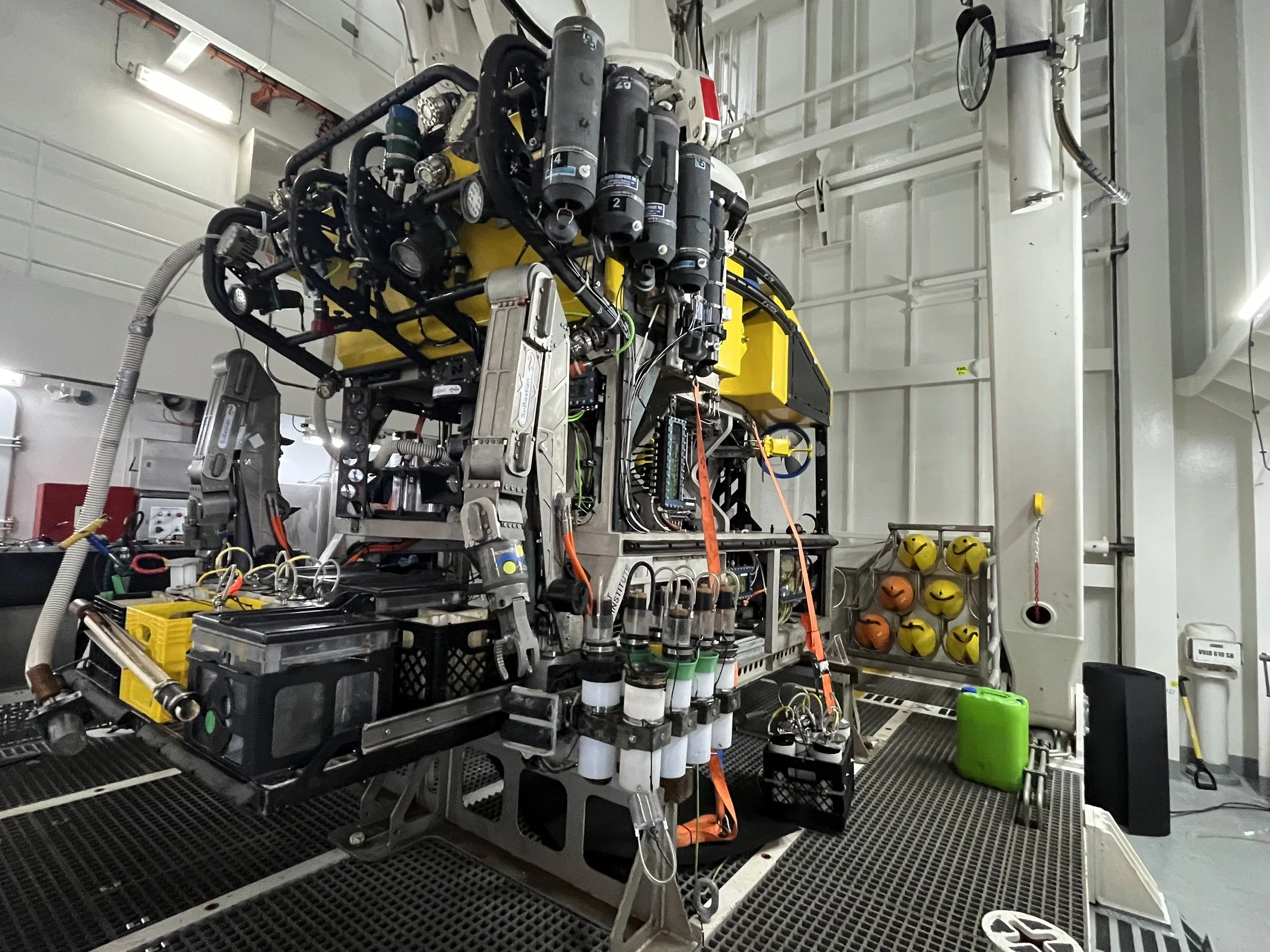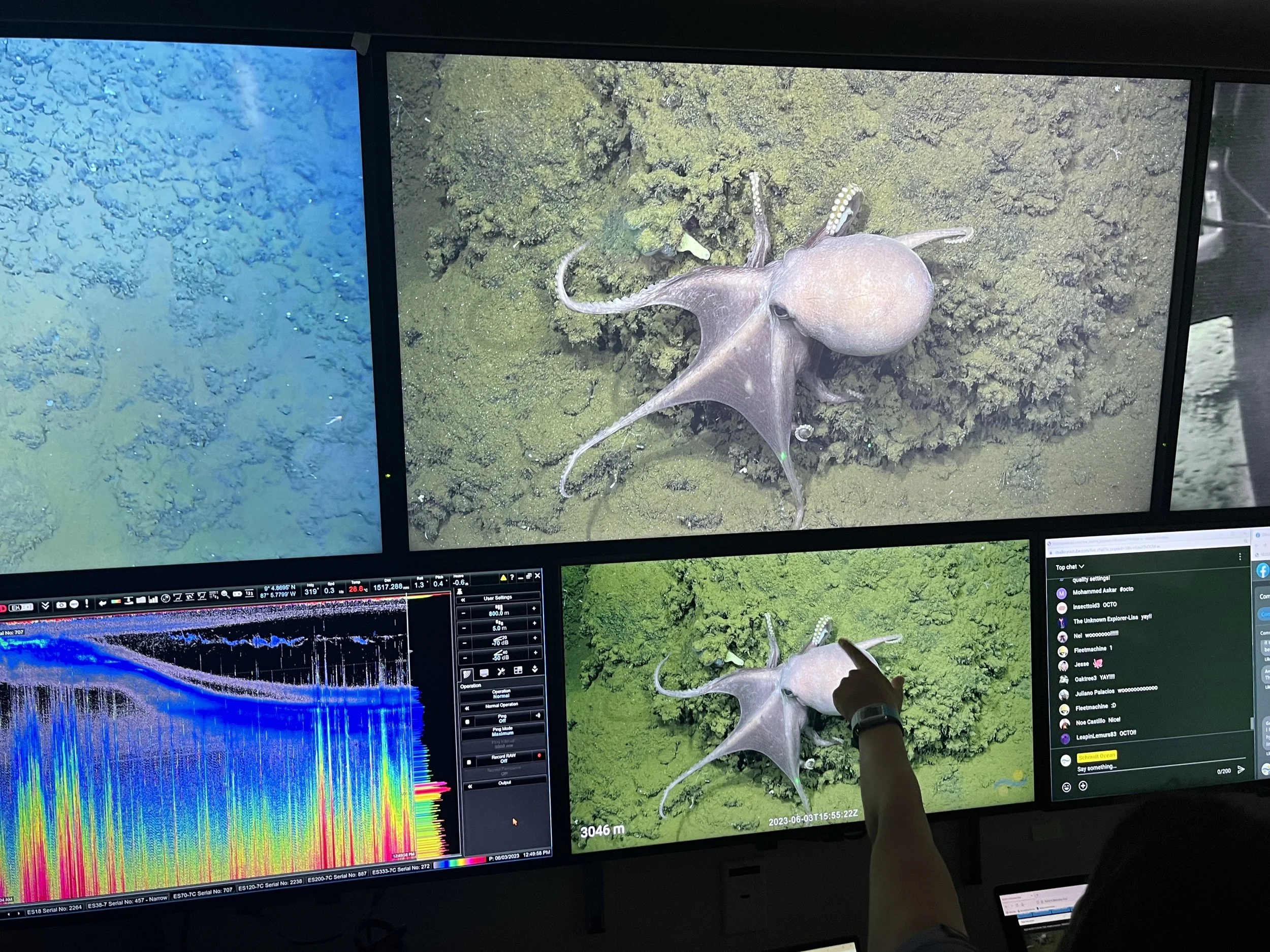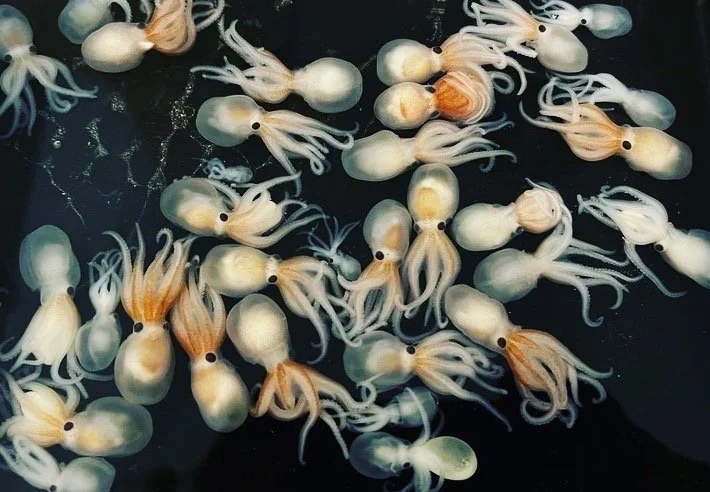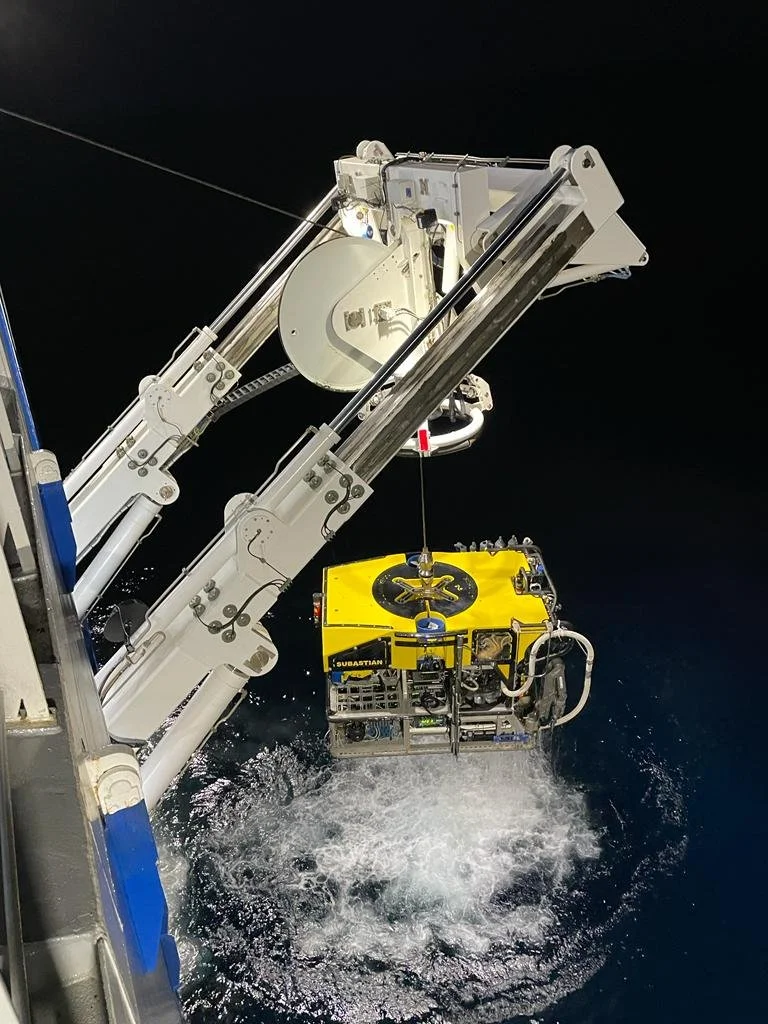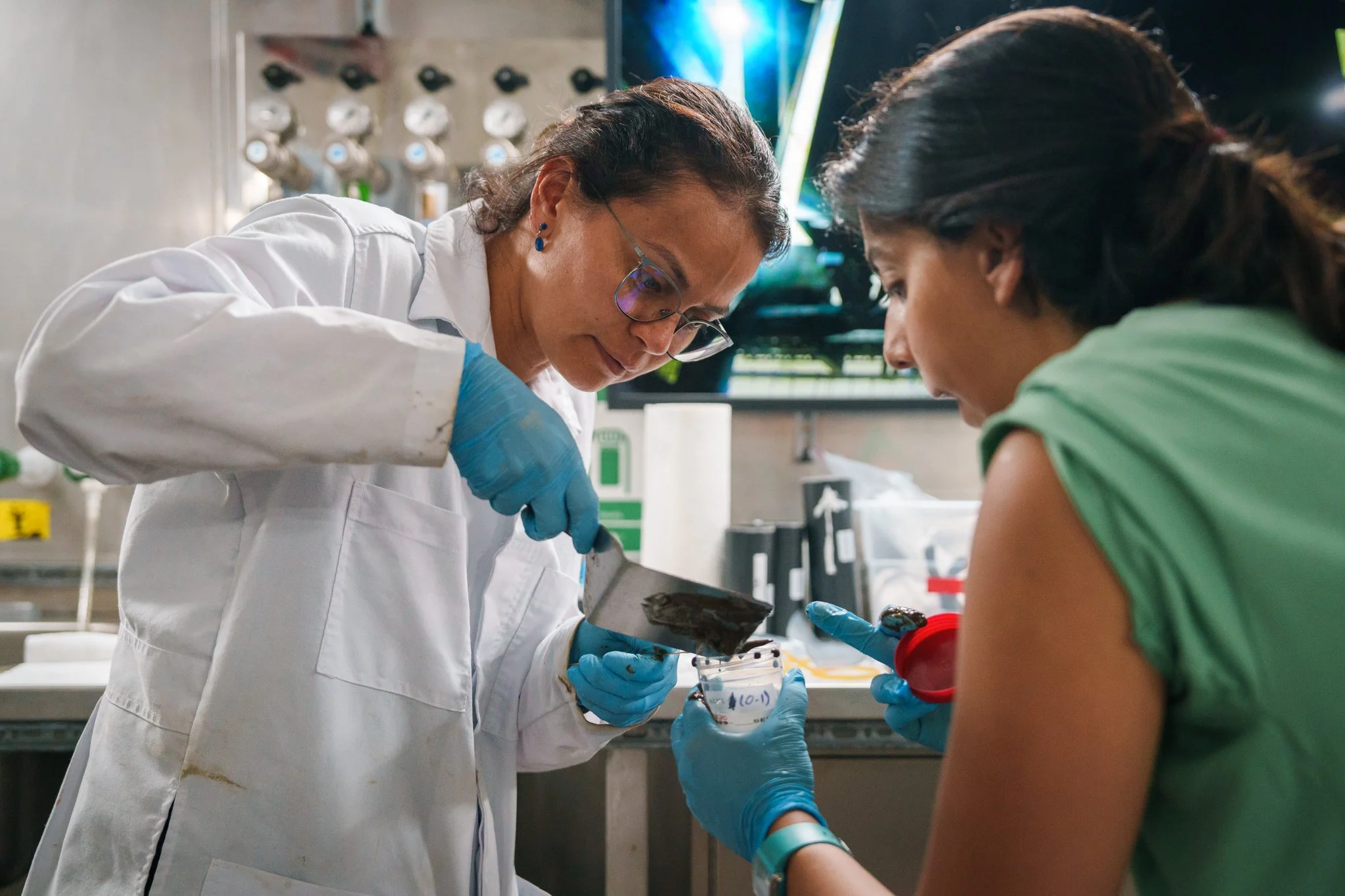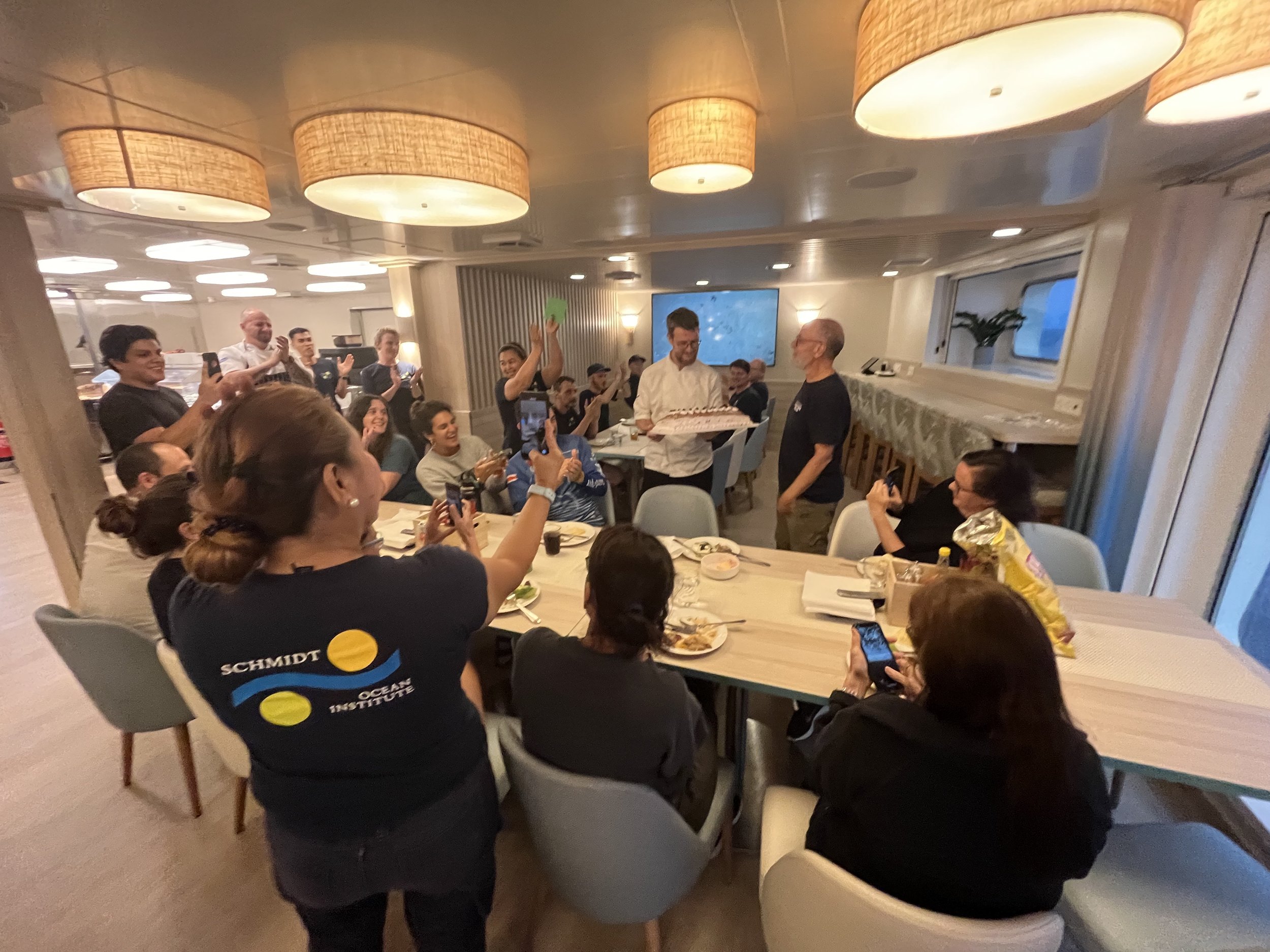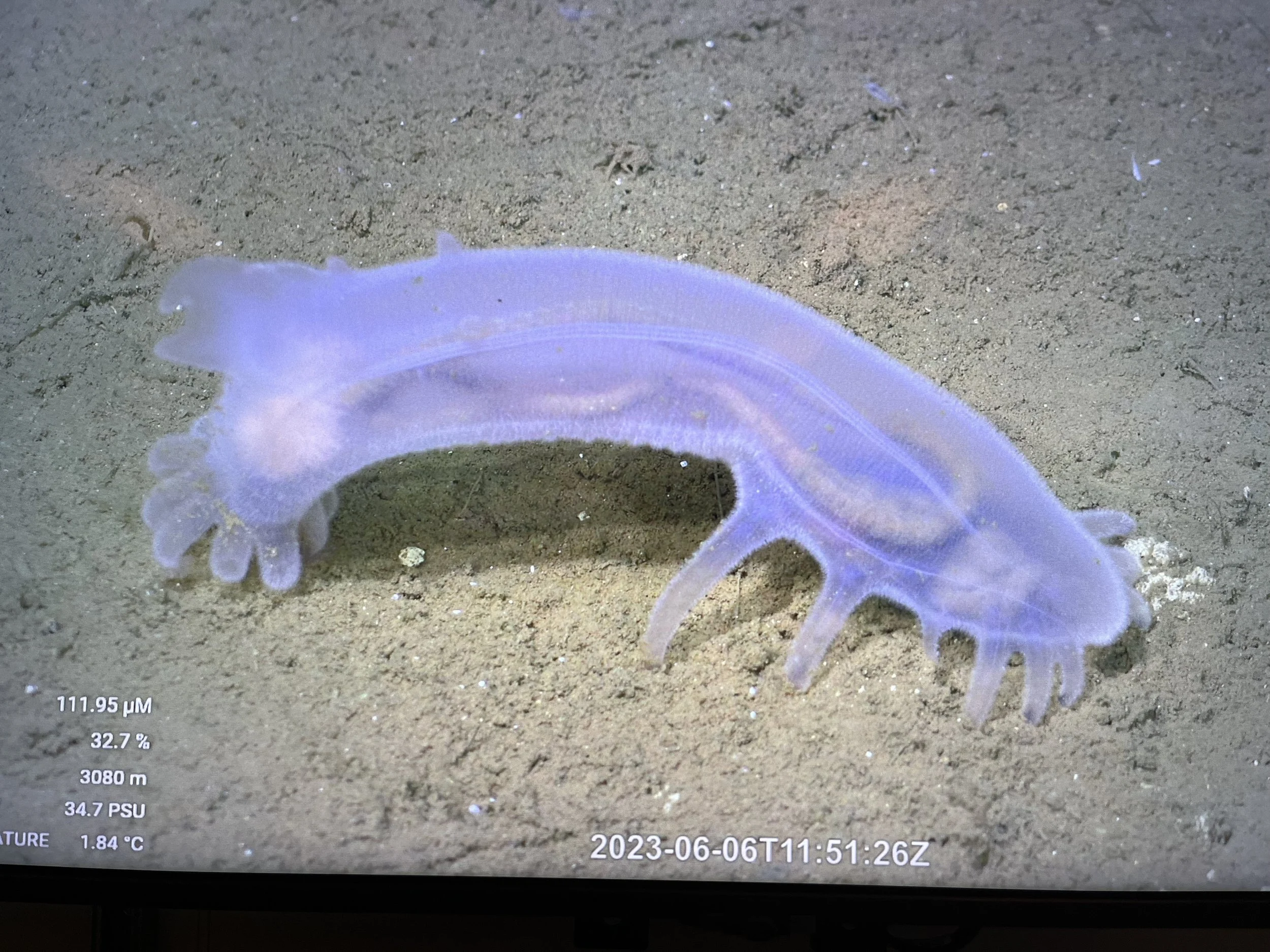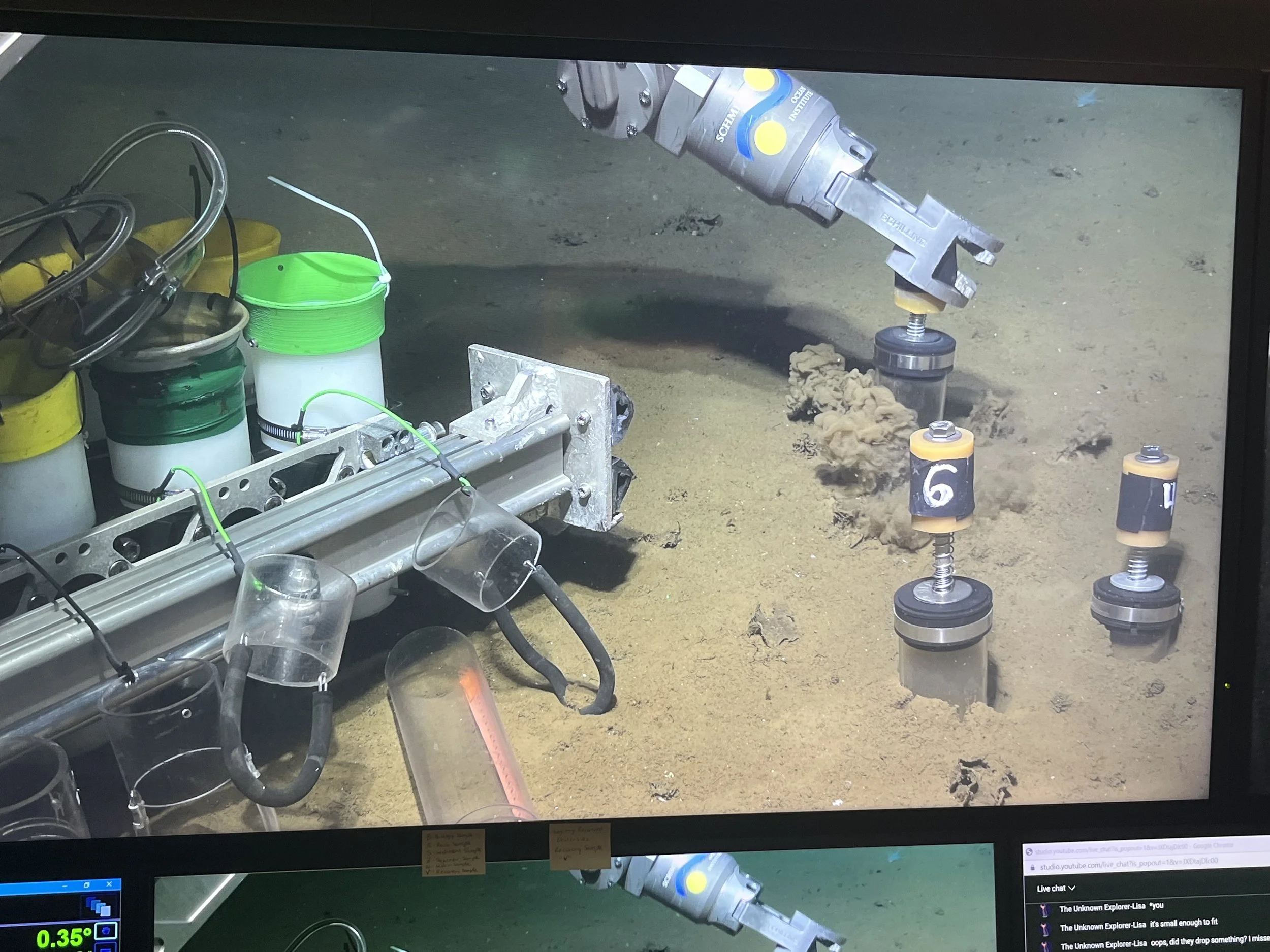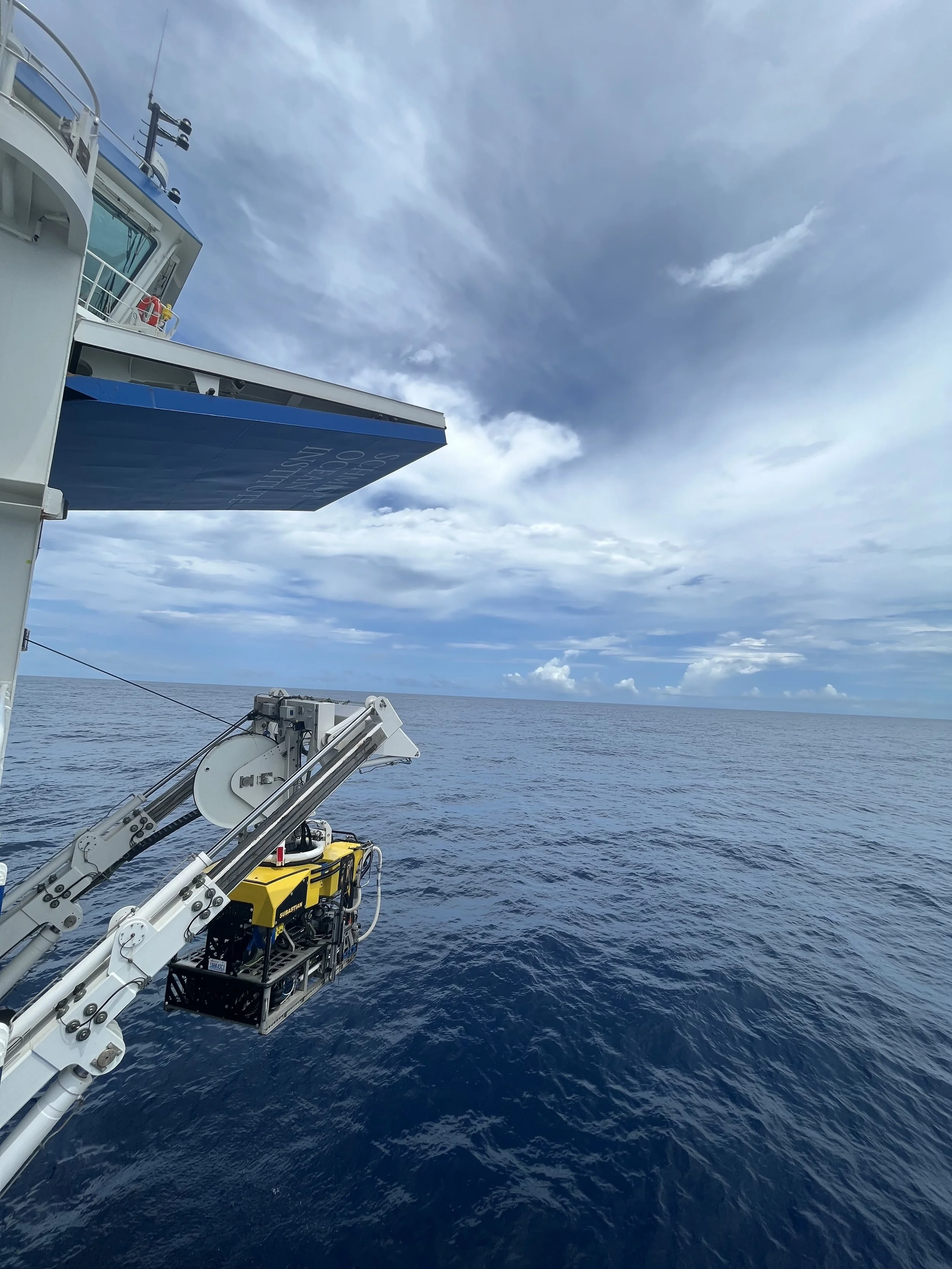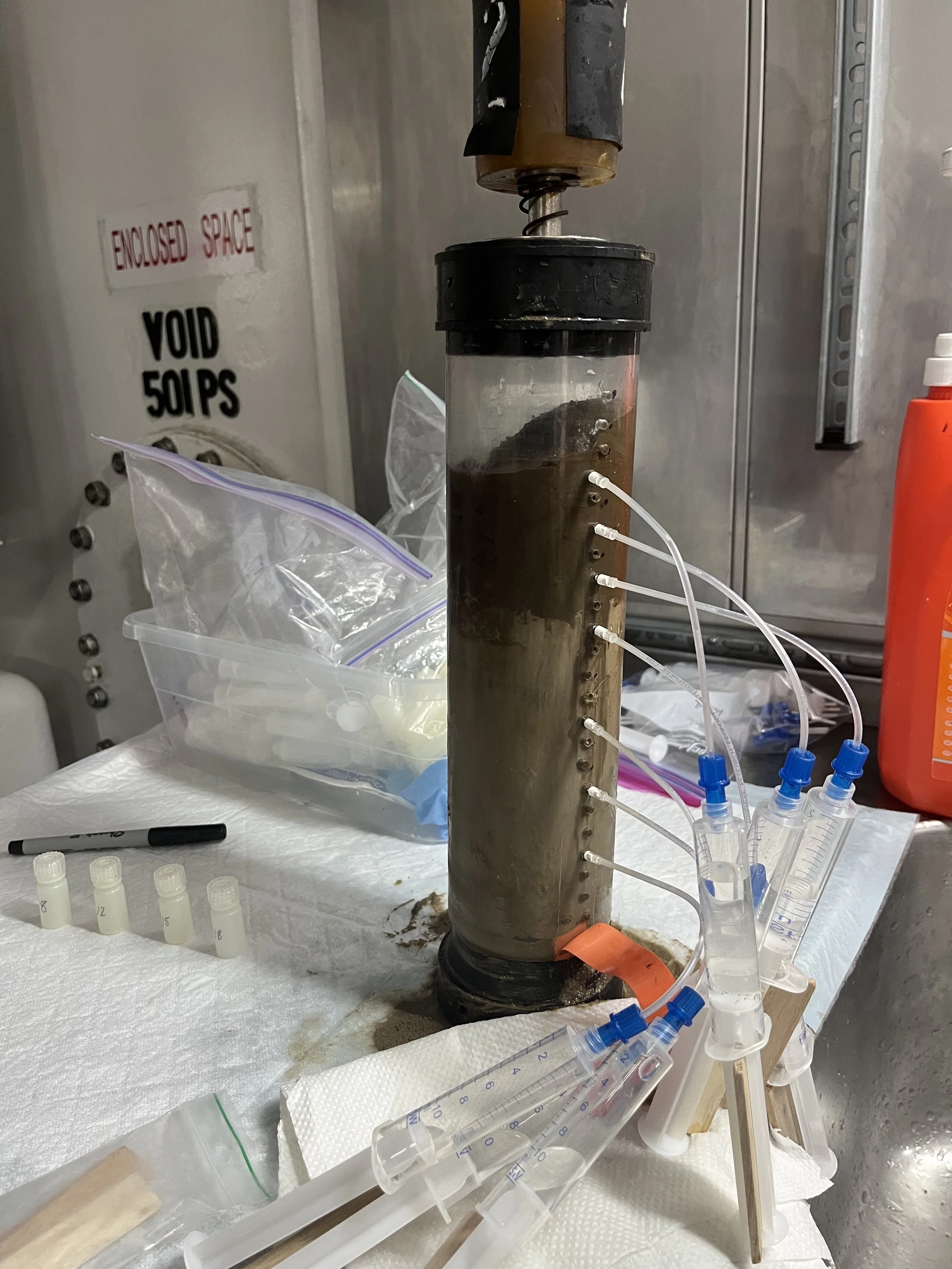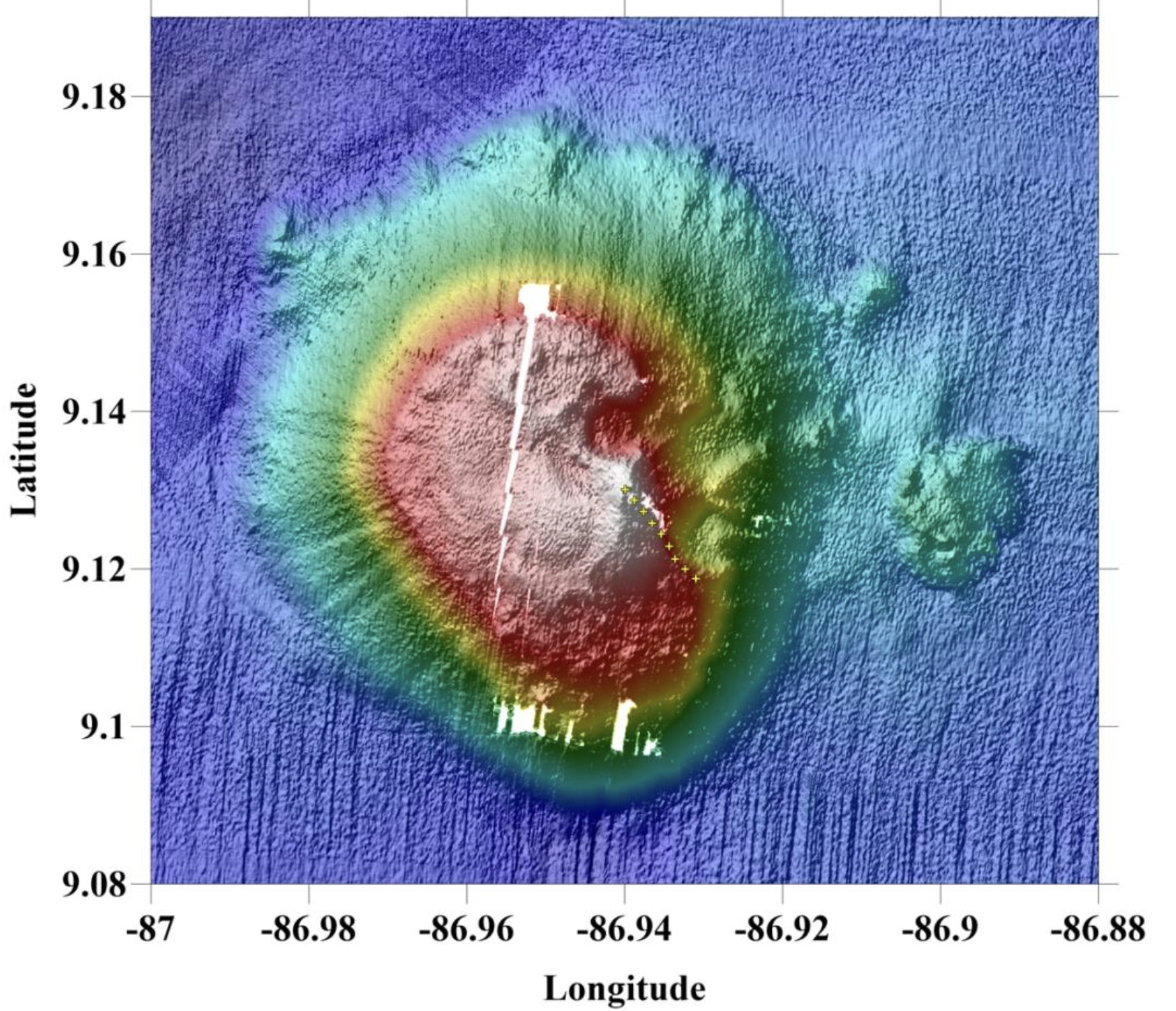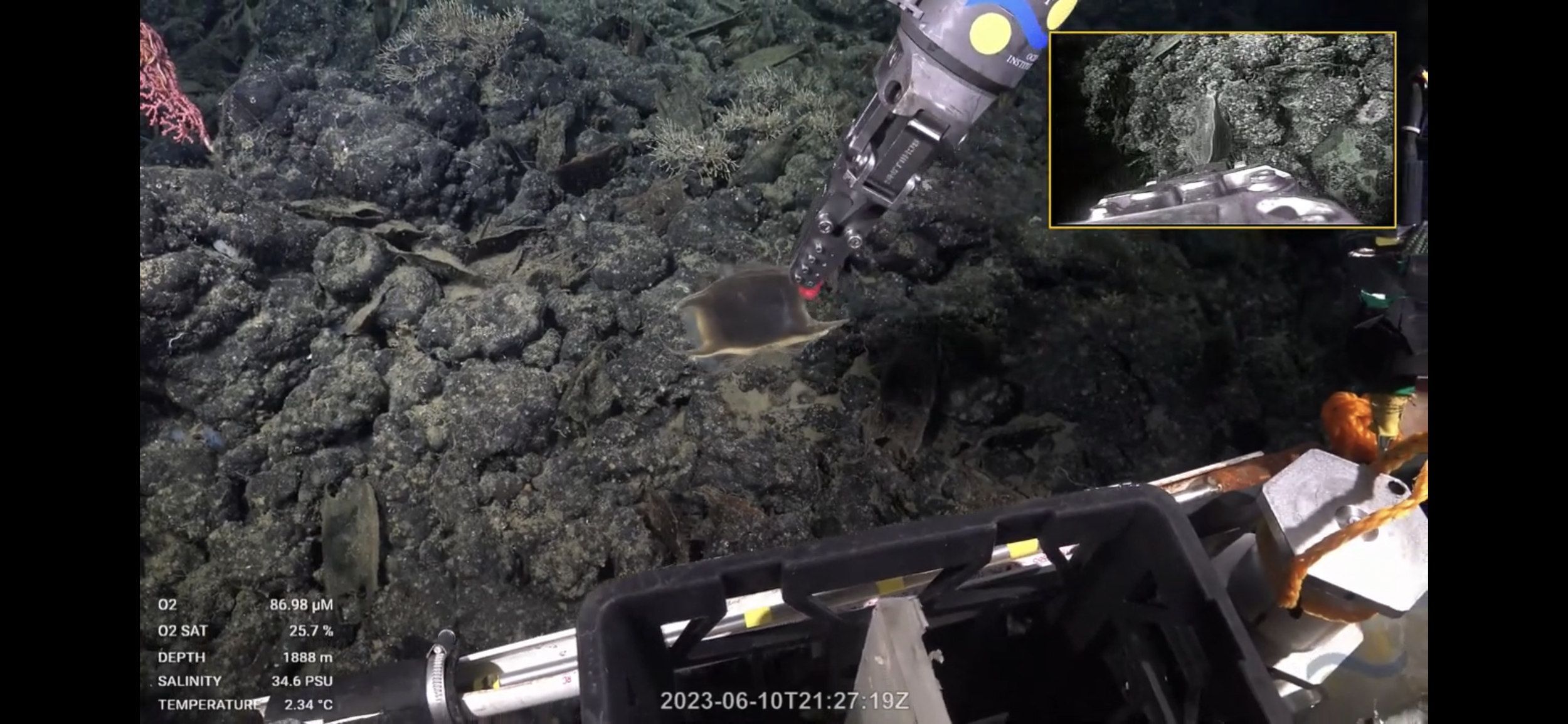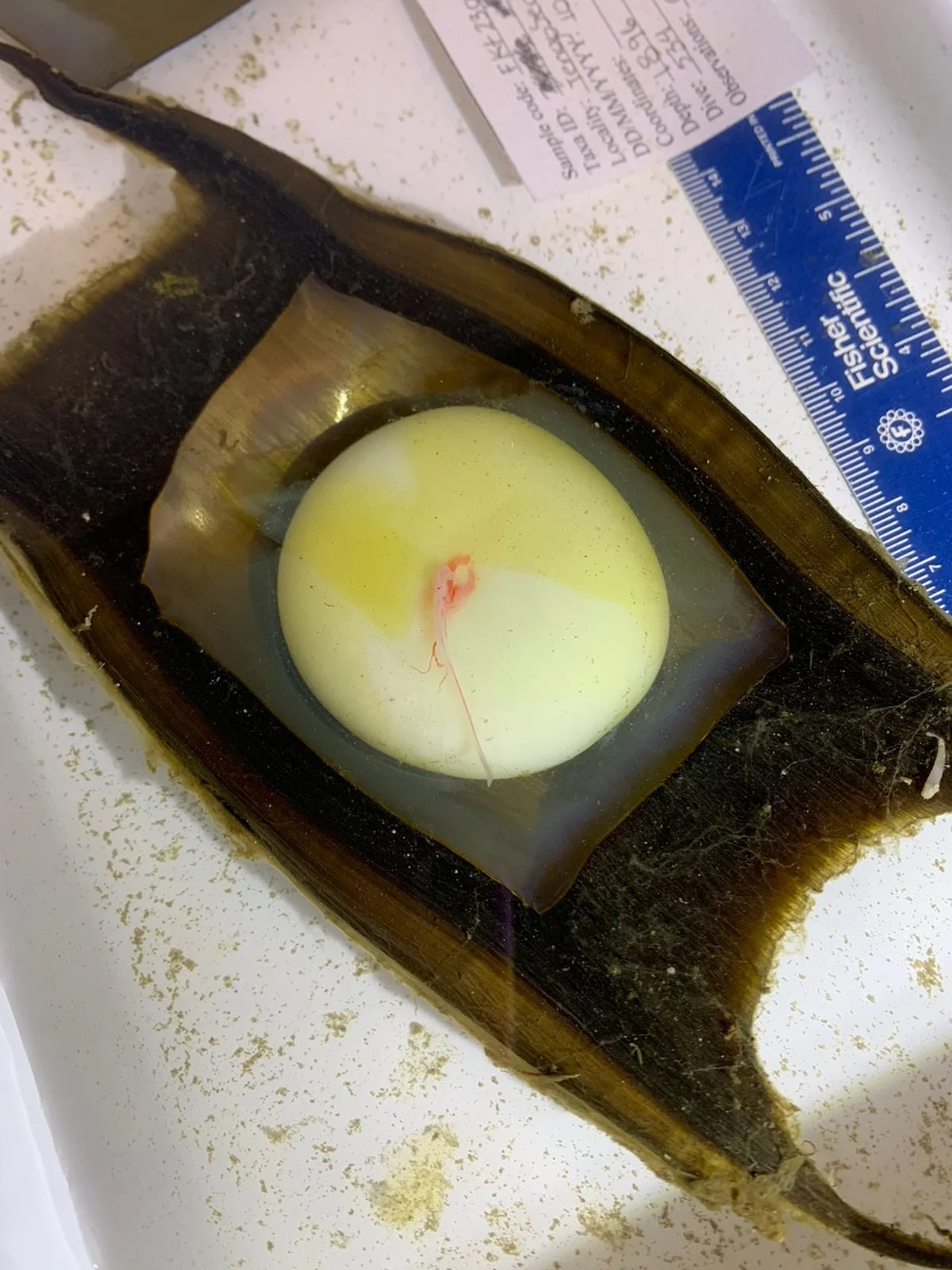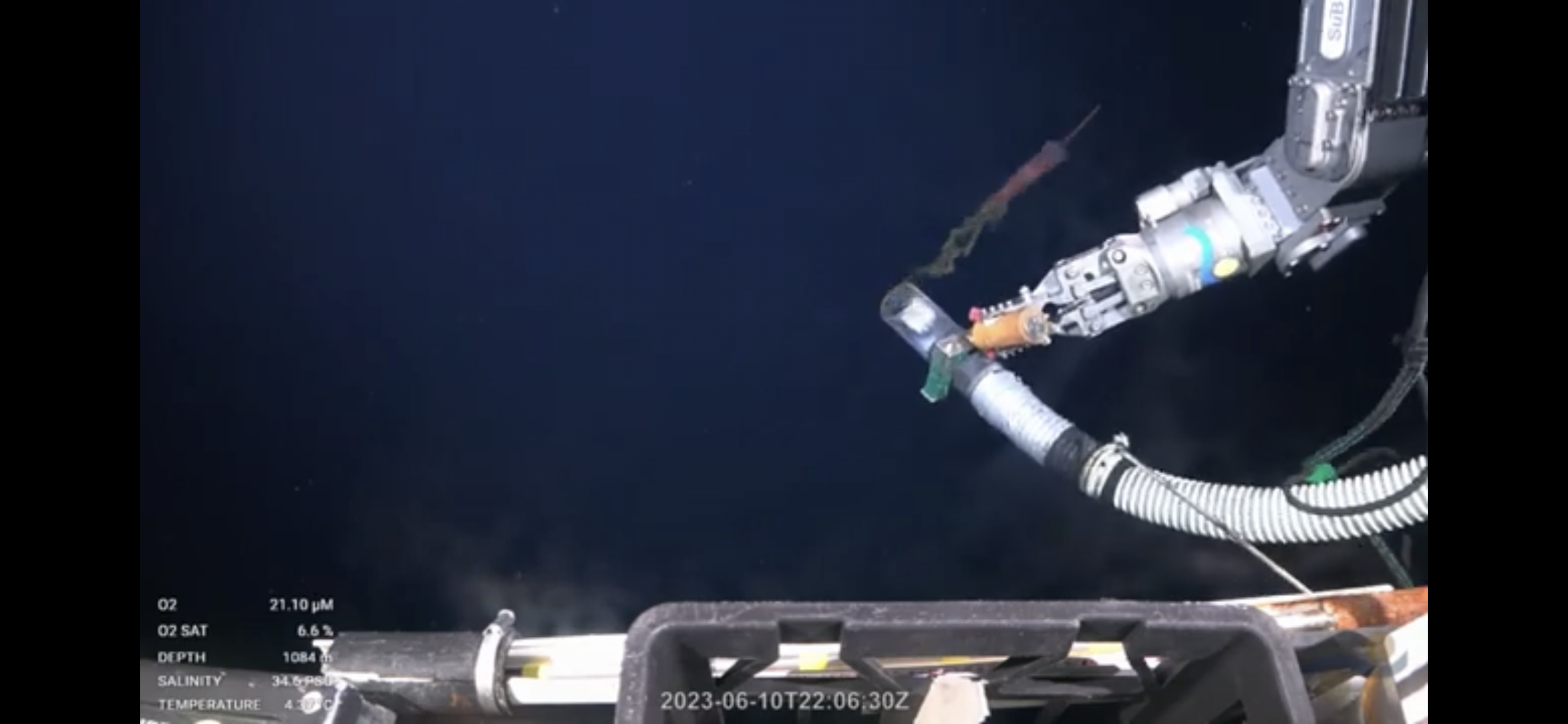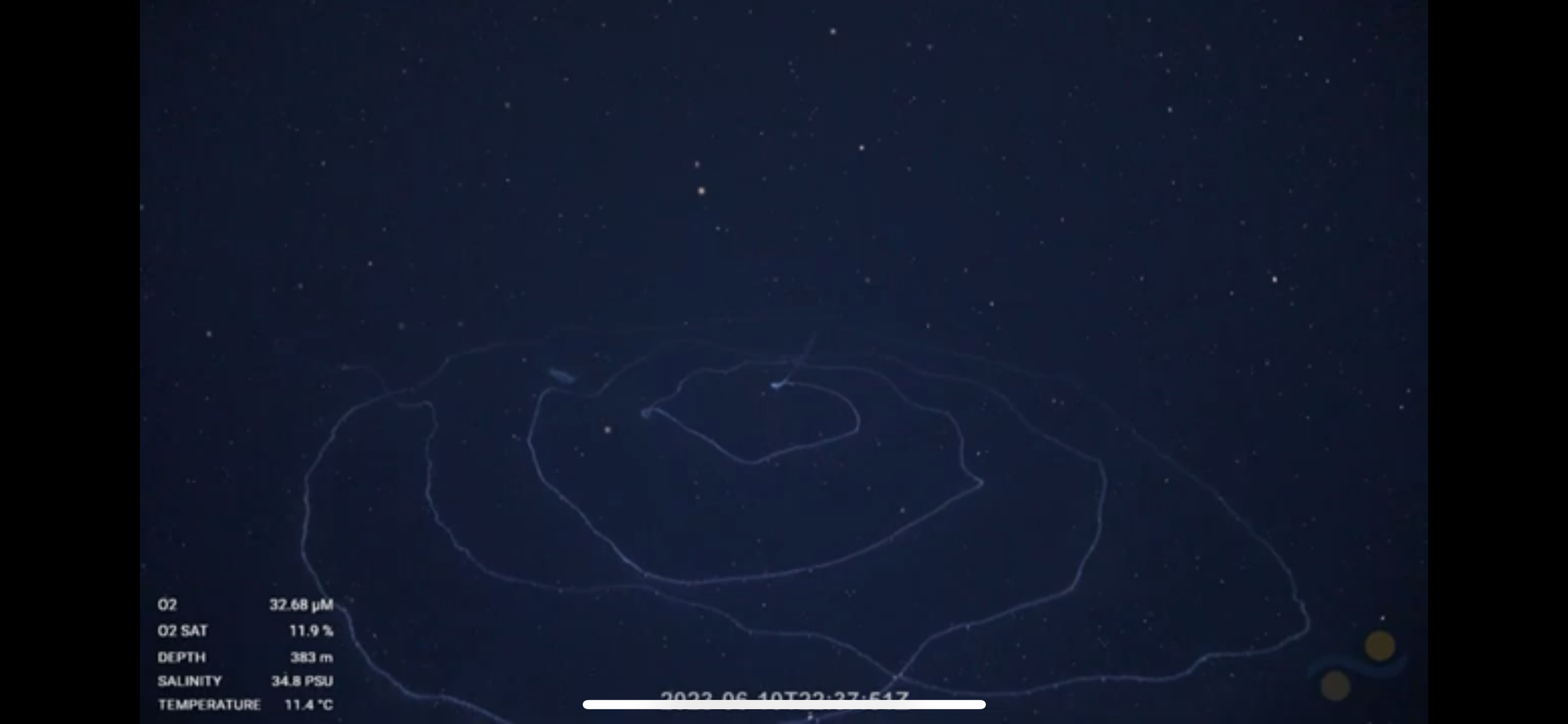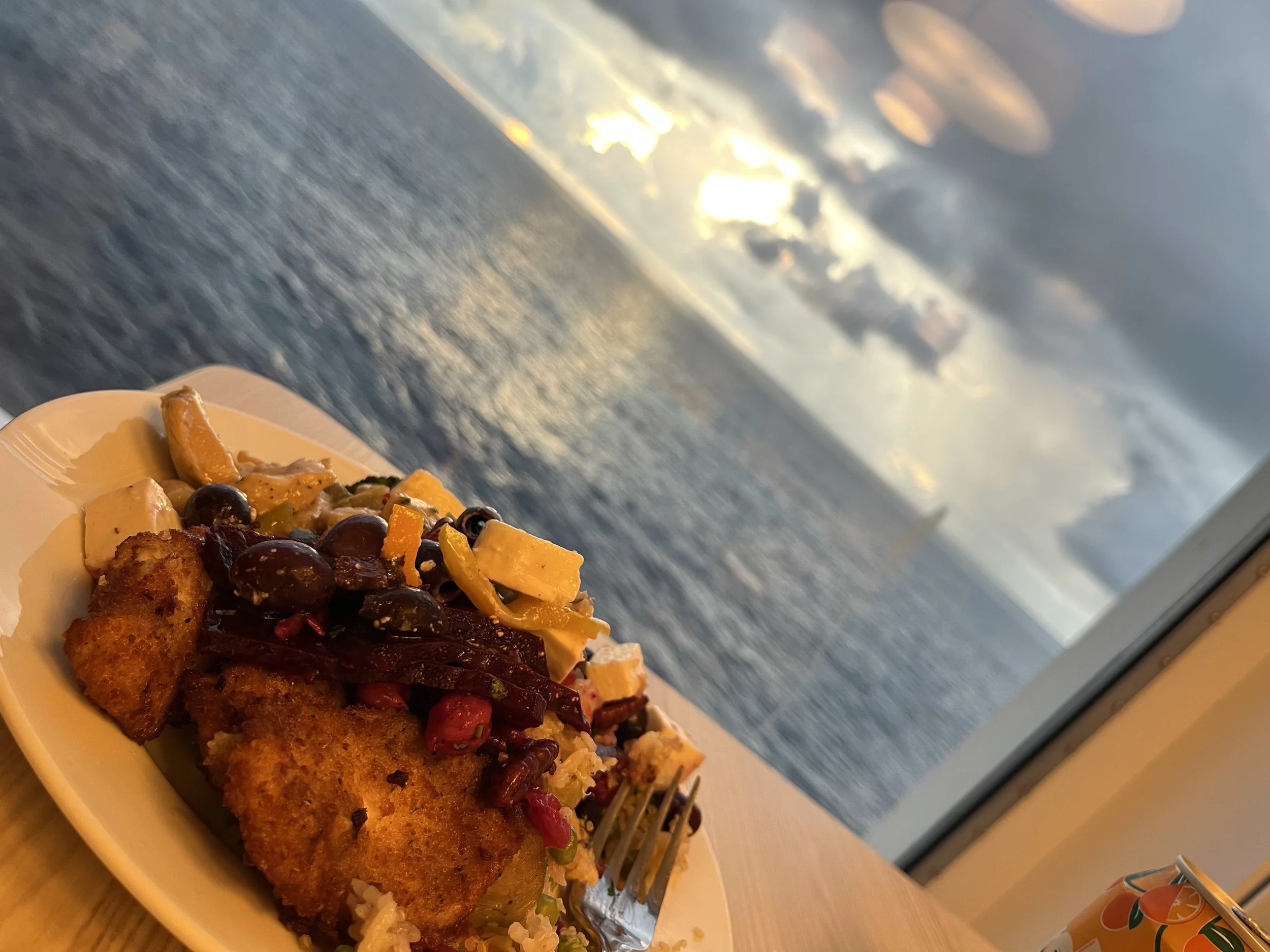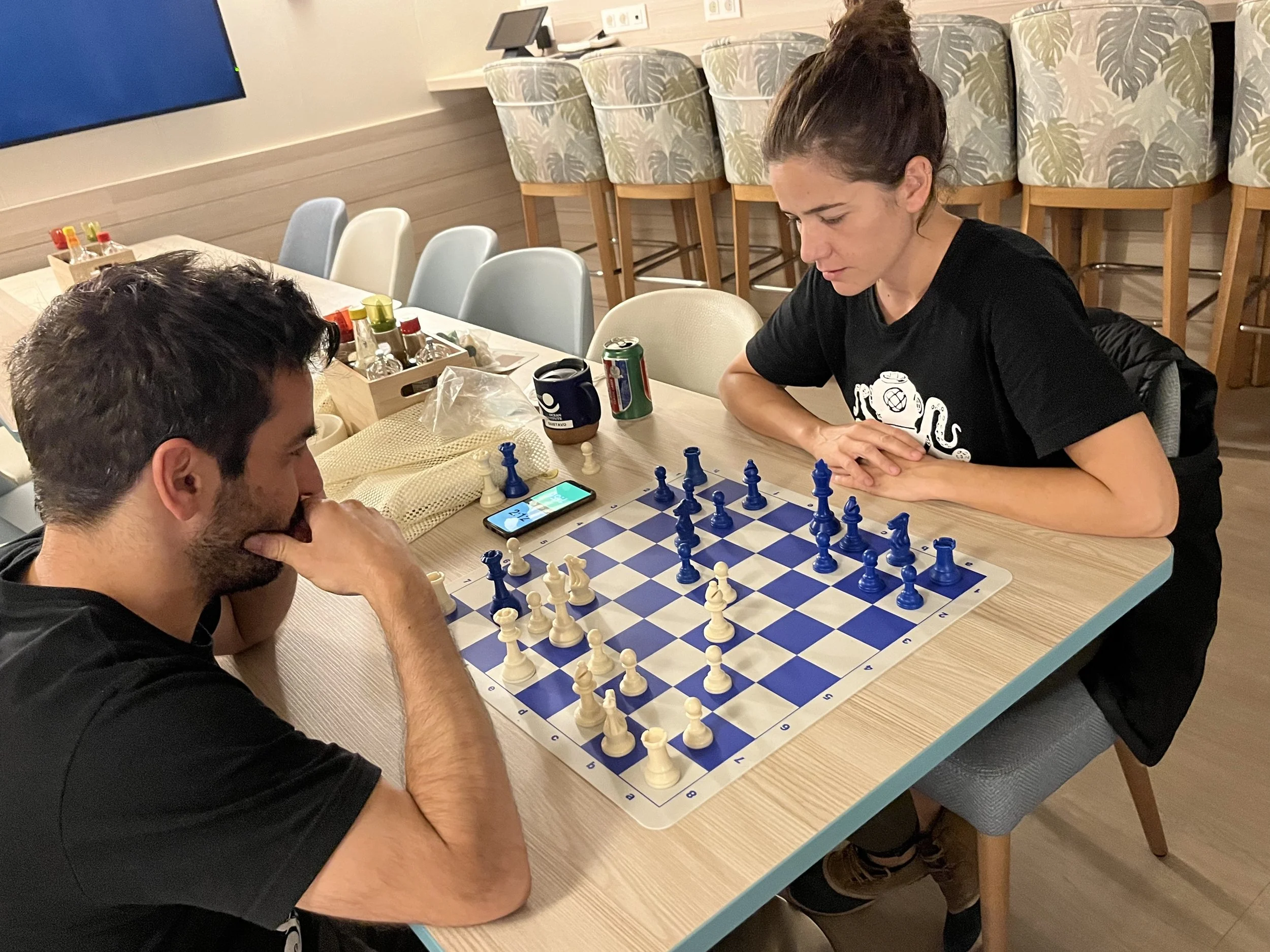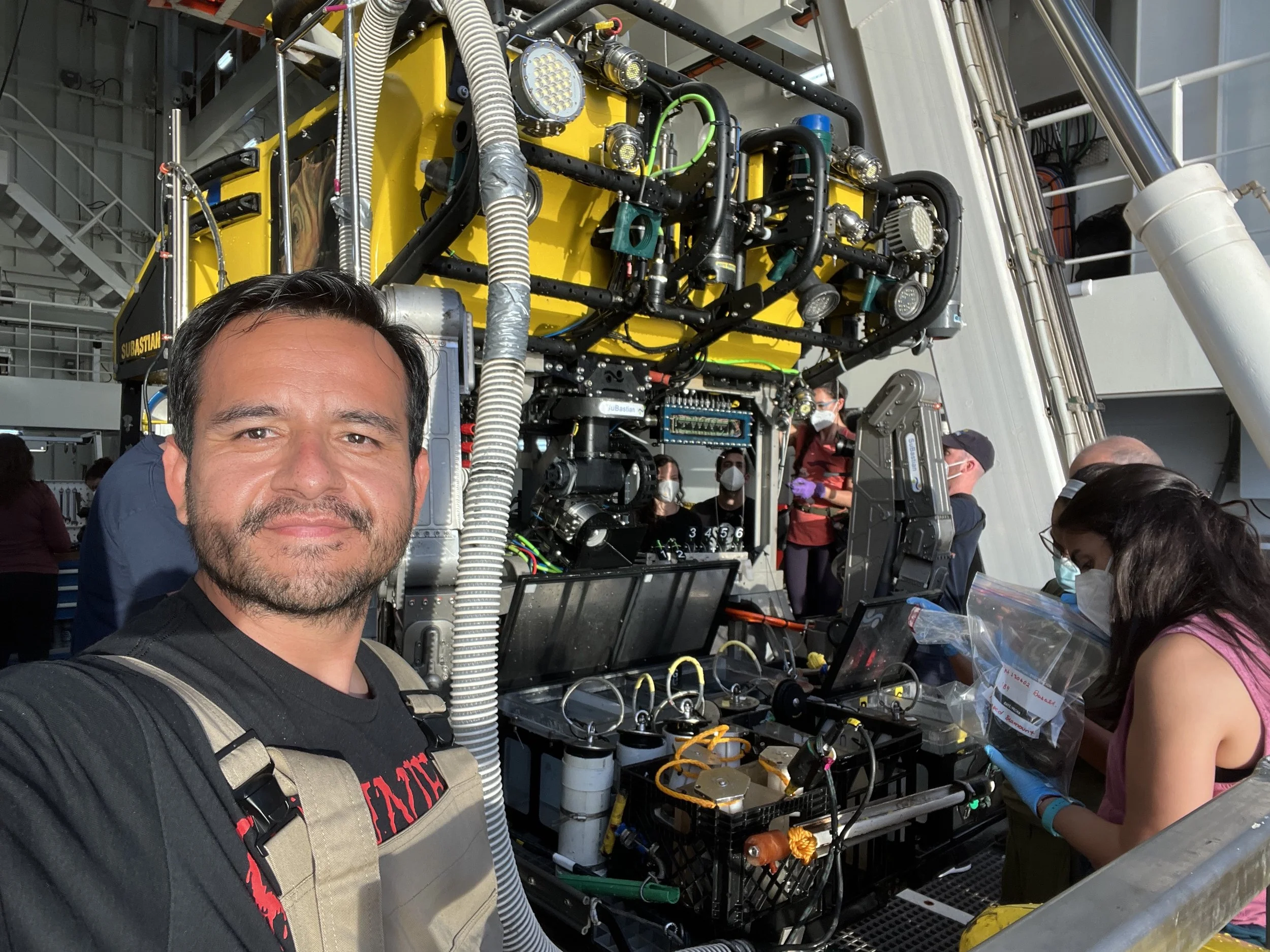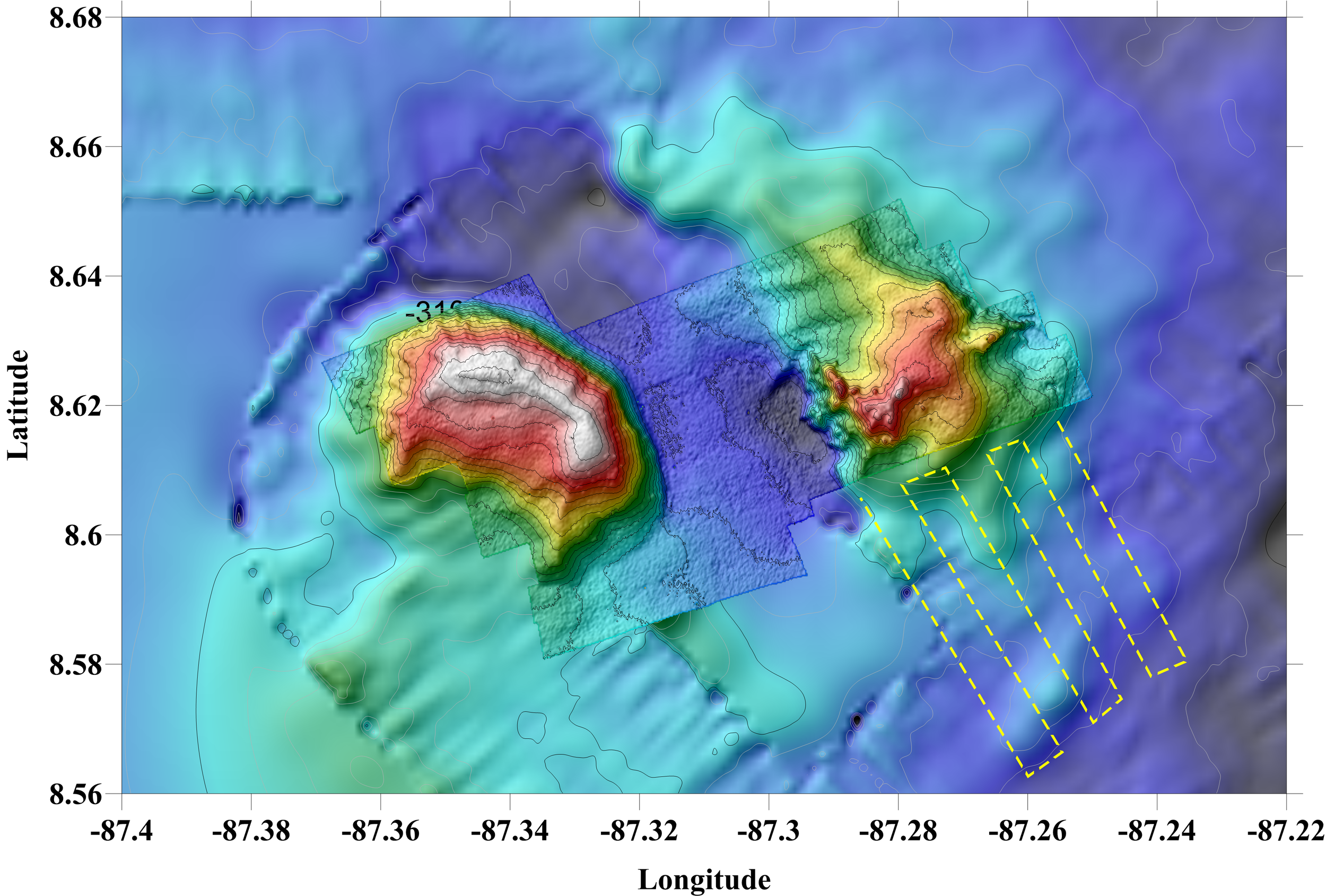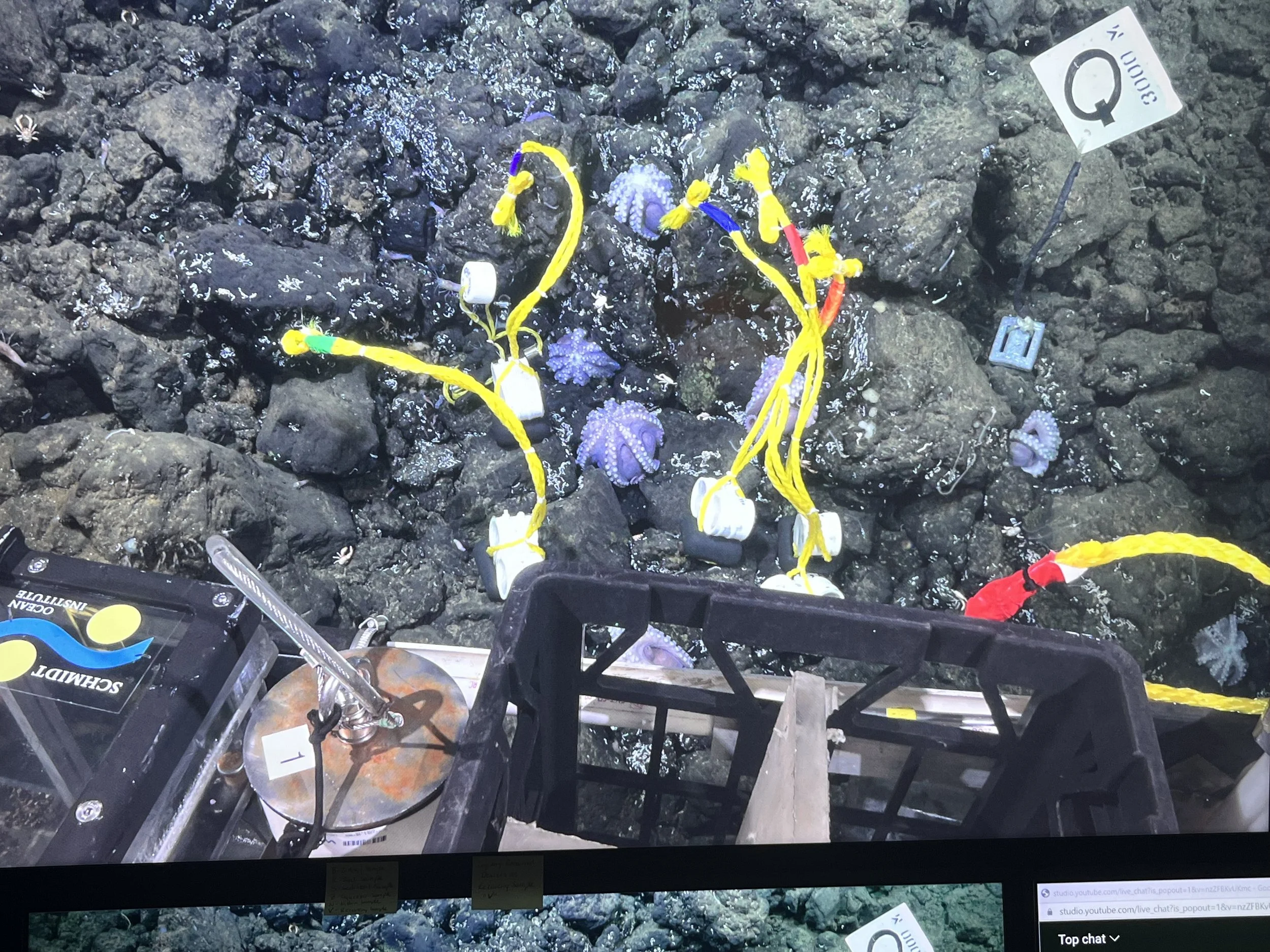Octopus Odyssey
Dr. Ramírez is spending 3 weeks at sea joining an amazing group of multidisciplinary oceanographic scientists sailing to explore seamounts in Costa Rica’s Pacific Ocean. Seamounts are underwater mountains of rock rubble. Previous work in the area discovered Octopus nurseries in these seamounts, where Octopus females appear to be attracted to sites of venting warm fluids to brood their eggs. This previously undescribed behavior sparked many questions: Are the females simply attracted to rocks that do not accumulate sediment due to the venting fluids that continuously “clean” the surface? Are the females attracted to a specific feature of the venting fluids themselves? Is the microbiome of females and eggs affected by the hydrothermal microbes that emerge in the warm venting fluids? Is the warm fluid’s slight oxygen depletion stressing the animals? The expedition hopes to generate data to address these and other questions regarding seamount macro- and micro-ecology. Join him as he explores uncharted seamounts and their ecology live online here and follow daily entries, representing personal perspectives of a scientist at sea, here!
May 29th
I departed Los Angeles bound for San Jose, Costa Rica. The 5h 20m flight started with wonderful views of another place close to my heart that I have yet to visit in person but have visited in dreams and explored through DNA analysis before: The Gulf of California, its desert landscape islands, and, specifically, Guaymas Basin under the waves. We landed in Costa Rica at 9:20pm local time. I settled into my hotel a couple hours latter and went right to sleep.
Gulf of California (Sea of Cortés) from my port-side airplane window. Flying over Baja California, south-bound, with the Mexican mainland across the sea. The blue of the waves, surrounded by the desert brown, perfectly blends into the sky. The atmosphere, hydrosphere, and continents blend effortlessly as pastel colors in an artist’s palette.
Photo Credits: Ramírez, GA
May 30th
When my first Central American morning rose, I had a wonderful breakfast and greeted old and new science friends from all over the world. I was particularly happy to see Beth N. Orcutt, our expedition co-chief scientist and all-around inspirational human being. I don’t see Beth often but when I do, something awesome is quite likely to happen, ha. The excitement in the air emanating from all the members of the expedition was clearly palpable. Hard to find another gathering with such joy. After breakfast we walked across the street to the San Jose campus of the Universidad Nacional de Costa Rica and started our day-long expedition symposium. We had seamount-focused presentations that ranged from the physics of heat transfer from the mantle to the sediments, local physical oceanography, conservation biology and policy management, the microbiome of marine sponges (presented by yours truly), octo-corals, microbe-rock interactions, and many other topics. As if all this was not enough, following our symposium, we walked over to a wonderful Spanish colonial church-like hall were we had a fine wine dinner and were delighted to have, Carlos Hiller, one of our expedition’s two Artists at Sea, and Sonia Bruno, a well-known Costa Rican Cellist, delight us with a live musical painting performance. The symposium concluding festivities, physically and conceptually merging science and art, were appropriate harbingers of the salty days ahead.
Dr. Beth N. Orcutt, our expedition’s co-chief scientist, delivering opening remarks at our pre-cruise symposium at the University of Costa Rica.
Photo Credits: Ramírez, GA
Octopus Odyssey Expedition Artist at Sea, Carlos Hiller, and Costa Rican Cellist Sonia Bruno delight the expedition party with an amazing hour-long musical and live painting performance.
Photo Credits: Ramírez, GA.
May 31st
Immediately following breakfast, we boarded a bus that took us to our rendezvous point with our ship, the Costa Rican port of Puntarenas. After many years of planning, we would finally board the Schmidt Ocean Institute’s Falkor too, our very own luck dragon! From the bus we boarded a small taxi boat and within a few mins, she was in sight! We boarded Falkor too with a rope latter and were greeted by the crew including the Captain, who also helped bring luggage up the port side hanger stairs to the cabins. A very warm welcome, indeed. Later, after a few introductions, we tour the amazing science facilities onboard Falkor too, finally meeting the remotely operated submarine Subastian, our hands and eyes on the seafloor! The day wrapped up with the set up of the science laboratory and growing anticipation leading to our collective tentacle-laced dreams.
First sight of Falkor too, our luck dragon, from our taxi boat.
Photo Credits: Alex Ingle / Schmidt Ocean Institute
Science party introductions at the mess hall.
Photo Credits: Alex Ingle / Schmidt Ocean Institute
Meeting ROV Subastian, our seafloor avatar.
Photo Credits: Alex Ingle / Schmidt Ocean Institute
June 1st
Our first morning on Falkor too made a few things clear, our food and our experience of it, as it was obviously the case with our science, would be second to none on the high seas. The galley is staff by amazing culinary artists that greeted us with classical and abstract concepts at every meal. One of the chefs revealed his finished and approved proposal insuring him Subastian dive time upon the next visitation to a high-temperature hydrothermal vent field to cook, using specialized (possibly patented) containers and seasoning, a meal for the ship at the seafloor using the heat from a black smoker! “This will place me in the Guinness Book of world records'“, he proudly stated. In a scramble to match the high bar set by all for this expedition, I put together my shipboard laboratory and helped colleagues do the same. After a few safety drills spread throughout the day, we gather in the aft deck, resembling a yacht, to celebrate our imminent adventure with a fancy ocean BBQ at 5pm with our departure to our first scientific destination, El Dorado Seamount, schedule for 8pm this evening.
Science meeting in main laboratory
Photo Credits: Alex Ingle / Schmidt Ocean Institute
Science party lounging in the beautiful aft deck space.
Photo Credits: Alex Ingle / Schmidt Ocean Institute
One of two charcoal grills responsible for speeding up the chemistry of food materials and bringing on the magic of our ocean sunset BBQ departure to the high seas.
Photo Credits: Alex Ingle / Schmidt Ocean Institute
Octopus Odyssey Expedition Departure
Photo Credits: Alex Ingle / Schmidt Ocean Institute
June 2nd
We spent most of the day in transit towards El Dorado seamount, a know octopus oasis first intimately explored 9-years ago. Previous work had identify this small seamount, about the size of a football field, as an important site where warm hydrothermal waters exit the seafloor. This so called “thermal syphon”, where slight differences in temperature in the first layer of the crust beneath the sediment, is responsible for cycling the entire volume of the Earth’s ocean through giant “rivers” (technically aquifers) that flow under the thick global sediment layer. Yes, there is an ocean in the bedrock below the sediments separated from the regular ocean we know! This process ultimately brings warm, chemicals, and distinct microbiology from the crust to the ocean above at vent sites like this one and dictates the chemistry of the ocean, atmosphere, and, ultimately, the oxidation-reduction state (the chemical signature) of the entire Planet! Another interesting note on Seamounts is the fact that, despite our targets sites being small separate sites not larger than a few football fields regionally, globally, this environment, where the seafloor literally rises above the blanket of sediments adds up to over 30 million square kilometers. What does this mean, you ask? Well, 30 million square kilometers is approximately the size of the continent of Africa! This means that an entire continent worth of seamounts, deep under the waves exists, where only a single football filed has been intimately (physically, geochemically, and biologically) explored. This is a great reminder of our business here is clearly as much exploration as “science”, which makes this all the more exciting! We arrived above our study site late in the evening and prepared for a very early morning first launch of the ROV Subastian.
Map of the Dorado seamount. The feature is depicted in meters beneath the seafloor.
Bathymetry data courtesy of Andy Fisher, Rachel Lauer, and Rob Perrin.
June 3rd
With a 4-8am watch shift, I was fortunate enough to awake to the excitement of the first seafloor sights! Subastian arrived at the vicinity of El Dorado seamount around 5:30 in the morning. Soon thereafter, we made our way to the slopes of El Dorado, where the seafloor topography quickly shifted from abyssal plains, resembling deserts, to complex rocks formations and a spike in life. Plenty of seafloor critters were there to greet us: Glass sponges, sea cucumbers, brittle stars, and other invertebrate friends. The anticipation and nerves build up in the room to see the cephalopods after who our expedition was named. There was no guarantee that the octopus garden sited here nearly a decade ago would be here again. After a few indications of larger rocks without sediment and a crescendo of scientific excitement in the control room, clearly fulled by the collective childhood wonderment that all of us there have worked so hard to conserve and integrate into our lives, it happened. A majestic male deep sea Octopus, with a clearly curled tentacle (a characteristic that allows sexing of these animals), welcomed us to their world. The room erupted with cheering and clapping, and this trend continued as the females came into the picture. An hour into the dive, we were surrounded by thousands of brooding females, nesting only on rocky crevasses where warm shimmering crustal fluids from the mantle rise through the cracks. Only there, do they commit to cementing their cluster of translucent eggs that they must guard in a complicated inside out embrace that may last years. The best part of this first dive was to follow. Previous explorers here, despite also seeing thousands of brooding females, were unable to confirm the viability of any egg clutches. We clearly identified small black eyes in many eggs that were staring back at us! If that wasn’t enough, when zooming out of an egg clutch, a single hatchling followed by dozen more, swam pass our high definition camera. The room burst with cheer!!! This magical moment was, of course, also captured by our two artists at sea, as involved with the moment of discovery as any of the scientist onboard this luck dragon!
Subastian, ready for action.
Photo Credits: Ramírez, GA.
Excitement building as we approach the rocky gates of the Octopus’ Garden led by world octopus expert Janet Voight (in red).
Photo Credits: Alex Ingle / Schmidt Ocean Institute
First Octopus spotted in this dive!
Photo Credits: Ramírez, GA.
Egg brooding females in the background. Microbial colonization experiments being deployed.
Photo Credits: Ramírez, GA.
A dive one inspired master piece by El Maestro Carlos Hiller.
Photo Credits: Ramírez, GA.
June 4th
Our second dive to El Dorado seamount brought additional excitement and, most importantly, plenty of geophysical, geochemical, micro- and micro-biological sampling opportunities. I was a happy camper, having deployed a set of microbial colonization experiments at octopus brooding sites , my primary goal for this expedition, and also having recovered plenty of mud for geochemistry and DNA-related stuff. This precious opportunity allowed us to collect octopus specimens, some the first of their kind, for taxonomic description and cataloguing, providing new knowledge for experts and the general public around the world.
El Dorado Seamount octopus hatchlings
Photo Credit: Dr. Holly Lutz
ROV Subastian upon its triumphant return to the surface world.
Photo Credits: Ramírez, GA.
Professor Maria Isabel Sandoval (white coat) and Dr. Maila Guilhon sample freshy collected hemipelagic sediment from the outskirts of Dorado Seamount.
Photo Credits: Alex Ingle / Schmidt Ocean Institute
Team sediment at work in the ROV hanger extruding push cores. No better way to spend warm late evenings at sea.
Photo Credits: Ramírez, GA.
Male octopus (note the curled arm which is actually a copulatory organ at the tip) patiently or frustratingly impatiently (who knowns!) awaits mating opportunities.
Photo Credits: Alex Ingle / Schmidt Ocean Institute
Artist at Sea Michel Droge draws inspiration from our Dorado dives to masterfully explore tentacled chromatic and textural motifs in a sketch pad.
Photo Credits: Alex Ingle / Schmidt Ocean Institute
June 5th
With two action-packed dives at El Dorado seamount behind us, we repositioned by about 22 nautical miles to arrive at our next stop, an unnamed seamount in the area. First things first, no map of the seafloor there existed, thus, our initial task was to send sound to seafloor and hear its response to make our map, a process called a “multi-beam bathymetry survey”. Lunch time also brought a special event, a birthday at sea celebration for our co-chief scientist Jorge Cortés-Núñez. With our treasure map in hand, we set out to find the gold: additional octopus nurseries at a seamount never before seen by human eyes. We first saw the seafloor at a site a few hundred meters away from the slope. From the sedimented plains, we observed a carnival of seafloor life. Sea cucumbers, brittled stars, eels, and giant sponges greeted us, to name a few. The first highlight of the dive was a tripod fish that, against the seemingly infinite blue/gray sediment plains, immediately transformed our screens into complete surrealist landscapes. As Salvador Dalí still chuckled in my ear, rock formations began to emerge from the infinite blue, and out of nowhere, an octopus was perched under exposed, sediment-free, rock! With official responsibility as a notetaker for the 4-8am shift, my evening ended a bit early. I planned to get to bed by 10pm to get a “solid 6 hours”, however, I accepted a chess challenge from my cabin mate, Dr. Miguel Semedo. In the evening dim light of the galley, rocked by the waves beneath us and with a 60” HD TV in the background streaming the live seafloor action below, I played ocean blue pieces (representing black) and responded with a King pawn move to a King pawn opening, as mariners from time immemorial have done before. After a very center possession-focused opening, and light square bishop controlled mid-game, a tension filled killer pawn endgame ended with my resignation. The current expedition chess score is 2-0 for Semedo.
Expedition crew celebrating our co-Chief’s birthday at sea.
Proto Credit: Ramírez, GA
Science dive turn surrealist masterpiece, tripod fish (or Salvador?) in the abyssal plains.
Photo Credit: Ramírez, GA
June 6
A 3:45am alarm means I started my day with about 4 hours of sleep. Despite this, curious about the seamount action a deck below, I jumped out of my berth surprisingly refreshed. The dive (S0531), after ~24h, was nearly over. During my 4 hour watch we recorded sediment temperature to get an idea of the heat release in the area. The physics behind that is way beyond my head, however, after speaking to Rob Perrin, a doctoral student in Professor Rachel Lauer’s laboratory, it appears as though there is significantly less of a temperature gradient in these sediments relative to El Dorado, meaning less of a chance of relatively high temperature fluid discharge here. After completing transects for temperature measurements (which means sticking a rod with a few thermometers into the mud and waiting to take an equilibrated reading), we were able to collect 7 sediment push cores for microbiological analysis. Subastian made his return from the depths again about 2 hours later. A sediment party began amongst me and the usual suspects (mud folk). After this, we had lunch and headed back to the lab to triple check our sample labeling and storage for what we thought would be an uneventful transit to our next target site, a seamount named Fuente. At about 2pm a text message came through the Whatsapp group chat from our co-Chief scientist Jorge, “New Species, BRAVO!!!”. It was only then, that I realized, that in our last dive, we had collected a completely new species of deep sea octopus, according to our expert onboard, Janet (who is pretty much the world authority on octopus taxonomy). A loud cheer and clapping erupted in the main lab! We will have more than new seamounts to name in this cruise… As a microbial ecologist new “species” seem to emerge in every study I’ve been a part of, however, it is hard to wrap my mind around the significance of such an event for the animal world. When exploring on uncharted mountains in the deep sea, secrets as old as time abound. Congratulations Janet! Following an evening lab meeting, Subastian returned to the seafloor, this time exploring another seamount called “Fuente”, never before seen by human eyes. Also, I can gladly report that, after a white queen blunder, I managed to finally win a game against Semedo (I played blue (black) pieces). The classical chess score thus far is 2:1 Semedo which I hope to further correct soon. Following my chess triumph, I had a bit of time to explore more of the wonderful recreation spaces on the ship and stumbled on a hidden room with musical instruments. Finally, I had a chance to practice George Harrison’s intro to Octopus’ Garden, a tune that will very likely come in handy as our adventure progresses.
Sea Pig
Photo Credit: Ramírez, GA
Sediment push core collection.
Photo Credit: Ramírez, GA
ROV Subastian returning to the photic world from after working 24 hours in the abyss below.
Photo Credit: Ramírez, GA
Porewater geochemical sampling. Sterile syringes and a special long nose filter are used to, using a vacuum, slurp mud juice out of pre-drilled holes on the side of the plastic core. These samples, collected at known depth beneath the seafloor (top part of the core above), primarily informs me on what microbes in the mud breath. The breathing menu at sediment this age includes, in addition to oxygen, nitrate, dissolved manganese, iron, and potentially sulfate.
Photo Credit: Ramírez, GA.
Jun 7
A new 3:45am alarm signified another very welcomed opportunity to get back in the ROV control room to explore the seafloor. The previous shift (12midnight-4am) had some good luck and reported observations of a few octopods at our 2nd never-before-explored site, Fuente seamount. During my watch, the most noteworthy observation was that of an interesting geological structure that resembled a coral- and sponge-decorated dinner table, complete with a bench, at the seafloor. Davy Jones’ chess table? In other news, two crew members (neither part of the science party) have tested positive for COVID-19 this week. As a precautionary measure, in addition to mandatary daily rapid testing for all onboard, the Captain has declared a COVID Level 2 status for the ship (masking in close quarters). In more inspiring news, Carlos is at it again and has generated what may be the first painting inspired by tripod fish, the highlight scene of one of our previous dives. As other watches progressed, we encountered alien sedimented landscapes accentuated by protruding white rocks that reminded me of scenes from Mono Lake, California. The biological highlight of the day would occur during my dinner. While in the galley a scream of excitement roared from all present, amazed at the august beauty and mystery of the famous, yet elusive, “dumbo'“ octopus. This creature amazed us with a display of its skirted tentacle flight/dance with intricate pirouettes, inspiring echos of warm Spanish musical nights powered by Gitano magic. Speaking of music, and if the scientific allure of the Falkor too wasn’t enough, I discovered a stash of ship guitars stored behind a couch in the cinema side room. The grand finale of the day was enjoying a great chess evening in the galley with Drs. Holly Lutz and Miguel Semedo. For those reading earlier blog entries, I’ve finally equalized my classical score (2-2) against Dr. Semedo! At 10am I hit the hay in anticipation for an early morning, 5am, expected ROV recovery.
ROV control room excitement as we explore the world of the tripod fish. Co-Chief Scientist Beth Orcutt (in the back), Professor Rachel Lauer (glasses) and yours truly, enjoy the wonderment of this tree-legged creature.
Photo Credits: Alex Ingle / Schmidt Ocean Institute
Davy Jone’s chess table? This incredible geological formation sparked plenty of conversation during my ROV watch.
Photo Credits: Ramírez, GA
What is perhaps the first depiction of the natural surrealism of the seafloor tripod fish.
Photo Credits: Ramírez, GA
Janet Voight, world Octopus authority, examines a new specimen.
Photo Credits: Alex Ingle / Schmidt Ocean Institute
June 8h
June 9th
We started one of two scheduled dives on “Tengosed” seamount. The name of this large (5Km+ diameter compared to El Dorado which is only a bit larger than a football field) seafloor feature is “I am thristy” in Spanish. The reason for this being the hypothesis that, given the colder temperatures there, water should enter the crust or be drunk by the seamount. Before our dive today, this place was only known by temperature readings and rough sonar mapping, today we became the first humans to “lay eyes” on it. We began exploring the Souther flanks of the seamount and slowly made our way around its paradoxically desert-like piedmont. As the geological features change, from flat sediment plains to crumbled rock fields, life emerges. Bare rock surfaces are prerequisites for corals and sponges to attach their base stalks. Once established these ancient animals bring along their friends. Shrimp, eels, skates, and fish adorn the stalked invertebrate rock plains, a seafloor strawberry field forever, it seems, where, given the darkness, living is, indeed, easy with eyes closed. Towards the end of the dive the goal become summiting this 1,000m underwater mountain. The way to the summit was laced with surprises, corals lined the final slope to the acme, creating a kaleidoscopic landscape of bare black rock with beautiful invertebrate chromatic accents. At the top, deep sea pacific skates, Bathyraja abyssicola, dominate the site. The rocks below show their investment, dozens of Mermaid purses (skate eggs) rest on the bottom. At the actual summit point, a giant sea anemone, well over a meter wide, with a pearl white oral disk and large rose-red tentacles regally crowns the mountain as its reigning monarch!
Bathymetric map of Tengosed Seamount.
Suspected skate egg nursery near the summit of Tengosed seamount. The ROV Subastian collects a mermaid purse to test the viability of the eggs.
Viable skate egg, further suggesting that the Tengosed seamount environment maybe a skate nursery, analogous to what we observed with Octopus nurseries at El Dorado outcrop.
June 10th
The day started with our second dive to Tengosed seamount. After about three hours of exploration on the side of a rock cliff, a quick zoom of the camera showed slight hints of shimmering fluid venting! Professor Rachel Lauer and her doctoral student Rob Perrin, team temperature readings, and myself, ran over to the control room to find our Co-Chief Beth already leading charge to further explore these potential shimmering fluids. After a temperature reading, the reason for our scientific excitement was confirmed, the shimmering fluids exiting a small crevasse in the mountain of rocks was exactly 1 degree celsius higher in temperature than the surrounding seawater, 3.22C in the vent vs 2.20C for background! What does this mean, you ask, well… This is potentially, the second confirmed site of hydrothermal low-temperature venting in this area, with the other observation of this phenomenon being the neighboring El Dorado outcrop. Our shipboard hydrothermal experts, will have to disentangle this complex physics puzzle, which is obviously way beyond my head. Importantly, professor Lauer stressed to me the that the low temperature difference between the background and venting temperatures, as opposed to Dorado, indicate that we may be seeing very local water circulation that only briefly enters Tengosed to rapidly exit there too. The dive continued on, gliding over an even larger skate egg nursery, eventually, as a finale, returning to the summit of the anemone king sharing dominion with its companion, a sponge colony queen! As the dive lead during the end, I, on behalf of all involved, sign us off this majestic peak of darkness with a buoyant liftoff, bowing to return in peace for all humankind soon. On the way up, a cautions squid avoided collection in an inky scaramouche. The entire science party, paradoxically, celebrated this creatures cunning stunt with cheering and clapping in the main lab. Our ascent would produce another remarkable sighting. At the upper edge of the twilight zone we encounter a giant. A behemoth siphonophore, several meters across, bid us farewell from the waters above Tengosed seamount. Being free from sediment duties during this dive (no sedimented sites were explored), I was delighted to help my macro-biologists colleagues. I happily joined the animal collection ranks in the specimen sampling queue leading up to the ROV sample rack. Octocorals, sponges, and, to my delight, wonderful weathered basalt rocks, were some of the treasures that I was finally, taking a break from my precious mud work, able to see and touch fresh. The excitement of the dive meant that I had a minimal, quick, lunch. Thus, come dinner time, I was ravenous. An ocean side seat at the galley, along with delicious mini schnitzel, brussels sprout salad, and garlic grilled mini-potatoes, all bathed in delicious black beans, restored my glycemic blood levels and by tentacle embraced “soul*”. As a perfect finish to another day of salty adventures, the chess crew, now officially comprised of Drs. Lutz, Semedo, and yours truly, played a single classical and a few blitz matches.
*: Artistic license or historical convention, no theological intent here what-so-ever!
The summit throne of the Tengosed seamount Monarchs, King Anemone and Queen Sponge, presiding over their kingdom of darkness and cold amongst their royal invertebrate court. Eternal guardians of Nature’s secret treasures. No doubt, a sight best enjoyed with Grieg’s own I Dovregubbens hall as the sound track! Our very own Costa Rican seabed Troldhaugen!
Squid: Nope!!!, Ink & Jets!
A siphonophore, perhaps tens of meters in length.
Frijoles negros a la schnitzel con vista a la eternidad del asunto, Mae! -Pura Vida.
A blitz battle evening. With 1 min and 56 sec remaining on the clock, having just indulged in a G-rank pawn capture by a sagacious queen attack, Dr. Lutz seeks additional opportunities for castigation against Dr. Semedo’s troops. Let history know that this battle raged on in the high seas, at approximately 9.25N & -87.0W, aboard the Falkor too barque, on the first hour of June 11th (locally, -6h UTC) of the 23 year of the 21st century, anno Domini*.
Another triumphant return of Subastian from the depths of the abyss. This is what we train for! Scientific treasure loaded ROV back to our surface world. All troops to main deck!
June 11th
Today after waking up from a fabulous lucid dream involving playing chess with black pieces against gold-hungry dutch skeleton pirates in a cave in the nearby Isla del Coco, I was glad to know that my on-going dream scientific expedition, is indeed my reality! As we mark the halfway point in our scheduled 22 days at sea in the Pacific, the excitement continues to crescendo. After breaking the fast, I proceeded to the top aft lounge (our literal yacht space, thank you SOI!) following our co-Expedition leader, Beth, reporting whale sightings port side astern. Indeed, binoculars at hand, I saw what others, more familiar with cetacean encounters, putatively identified as Pilot Whales. The pod, bobbled at a distance, 300 yards, 200, until repositioning to about 100 yards astern from the boat. These ocean ambassadors inspired the scientists and artists alike. I spotted flukes and spouts, noting a healthy pod size of about 7-10 individuals including what appear to be infants. A large bull lifted half his body off the water to take a good look at our vessel. After inspecting our bipedal troop, rift-draft in this domain, he perhaps wondered if intelligent life could have ever evolved in an extremely remote, hostile, and inaccessible environment as terra firma. To me and the pilot whale pod, that is still TBD… Scientific business proceeds, at 7am the ROV Subastian was back at the seafloor, now charged with yet another exploratory dive at, yet another site never previously visited by humankind: An unnamed feature a tenth of a degree East of a larger seamount informally known as “El Caballito”. After a few hours at the seafloor there we failed to see direct evidence of venting, however, our onboard physicists Rachel and Rob, were able to get warm temperature readings from the sediments in the vicinity of this unnamed feature, implying that fluid flow from the rocks around the edge is to be expected. We shall return tomorrow! This evening activities included an impromptu guitar jam session with the science crew. The playlist include songs by Caetano Veloso (Sampa, which Dr. Guihon, a Brazilian native, explained to me is short for San Paulo, her home town), RHCP, a Foo Fighters. As the evening progressed, a switch to a Spanish repertoire led to Heroes de Silencio, Shakira, and Fabulosos Cadillac jams. With music, floating in a sea of darkness with a sky so clear, the milky way seemed within reach, we ended a wonderful evening as we watched far away lightnight storms in the horizon.
Two unnamed seafloor features in the Costa Rican Pacific. The incompletely mapped one to the East (right, note the planned planned raster lines directly below it) is putatively called “Caballito”.
One of our two artists-at-sea, El Maestro Carlos Hiler, working on the next ocean masterpiece from the beautiful yacht-like aft lounge on the morning of the hump day of our expedition.
ROV Subastian breaching the hydrosphere-atmosphere interface after another successful mission completed.
Photo Credits: Alex Ingle / Schmidt Ocean Institute
Yours truly rejoicing in the latest sediment core sample bonanza delivered by ROV Subastian.
Photo Credits: Alex Ingle / Schmidt Ocean Institute.
Jun 12th
The day started off where yesterday’s dive left off: anticipation due to strong indications of additional hydrothermal venting fluids in the area and, potentially, new Octopus gardens. After a few sightings of the charismatic bony-eared “assfish”, Acanthonus armatus, we were back on the ocean floor. I had a few side engagements, a morning chat with a media correspondent followed by my second ship to shore event of this expedition. The ship to shore, a co-performance along with Professor Lauer, allowed us to tour the ship and talk about science with 300 kids from the USA and Canada remotely. Following that engagement, and to the absolute jealousy of my 16-year old self, Alex Ingle, our expedition’s official photographer and media correspondent, asked me to record a short original song I composed as background music for our next weekly summary video diary which I titled “wonderment”. The recording took place in one of our ships amazing recreation rooms; however, the quick recording turned into an amazing concept for a video. Given the unusually clear skies and blue prairie flatness of the sea today, he asked me to jam at the end of the aft deck while he flew the camera drone for aerial shots! I felt like Slash playing a guitar solo in front of the white church during the November Rain Guns and Roses video, minus the unlit cigarette in the mouth and incredible talent of Slash, of course lol. As if the day couldn’t get better, upon stowing away the six-string instrument, I found myself in the main lab and, wow, a new Octopus Garden was emerging on the live stream video from the ROV three thousand meters below us! This unnamed feature next to “Caballito” really delivered the goods! I was able to deploy a second experiment at a brand-new low temperature fluid venting Octopus nursery. This day was massive for my actual job, science, and my rock n’ roll pipe dreams. Feeling as though as I was achieving Nirvana*, a sudden mood change in the control room was palpable. Our expedition co-chief, Beth Orcutt, was hastening (with the characteristic finesse, decisiveness, and tactfulness of her fantastic leadership style, as always) planned dive activities and requested a science party meeting two-hours before the originally scheduled time, ending a dive an hour early. Without asking questions, we attended the meeting to find out that, a single COVID-positive crew member, who had been in isolation for a few days now, would require transport back to land as a precautionary medical measure as per orders of the Captain. Despite this situation, the crew and science party remained in good spirits and the work continued. Once Subastian was back on deck, the biological samples collected during the slightly truncated dive were catalogued and stored by the science crew as we started our steam back, having wonderful US Military escort and carrier high sea encounters, towards Puntarenas. The an over-the-board evening, with the usual suspects, ended with a hell of a lightning show.
A new Octopus Garden discovered and new microbe-rock colonization experiment deployment in an unnamed feature East of “Caballito”.
Our amazing bilingual ship-2-shore crowd, remarkably inquisitive middle schoolers from Corpus Cristi, Texas. Howdy y’all!
A rare sighting: A bony-eared “assfish”, Acanthonus armatus.
Jun 13th
Land ahoy! The morning brought with it the first sight of land in almost two weeks. We are on our way to perform a precautionary medical evacuation from our ship. We will also leave, Esteban on land, a Costa Rican park ranger joining us as a local government observer usually stationed in Cocos Island. He told me that one of his primary responsibilities included keeping treasure seekers aways from the lore of the pirate treasure of the island. Despite the historical certainty of Spanish Galeón shipwrecks and, centuries later, Nantucketers with spermaceti dreams in the area, the doubloons remain elusive. I revealed my full intentions to find the treasure hoard using Fe-leaching measurements from NASA satellite data which could lead me to unknown wreck sites. With a chuckle, I also told him that once I found the gold, he’d be at the top of my list of people I wouldn’t tell! Ha! Esteban is an all round great guy, however, his Octopus Odyssey ends today. A group photo, in full expedition gear is scheduled for later this morning and then it is back to the high seas to resume our scientific work. On the sail back to our seamount grounds, an hour long science meeting helped us rehash our top dive priorities. Tomorrow we return for our third dive of the cruise at Dorado, where I expect to deploy a second set of colonization experiments. The evening ended with a chat with Gigi and the august Augustus. Followed by catching up with my own lab group (the new undergrads) back home as well.
Esteban’s Octopus Expedition ends. We cheer him on as he waves from the bow as he is carried back to land via taxi boat from Falkor too in Puntarenas, Costa Rica.
Standing next to the lead instigator in some of the coolest ocean science ever done, the one and only Beth N. Orcutt, our amazing expedition co-Chief. #OctoOdyssey Captain.
Next set of microbial colonization experiments set to be lowered at El Dorado during tomorrow’s ROV Subastian dive (S0537).







